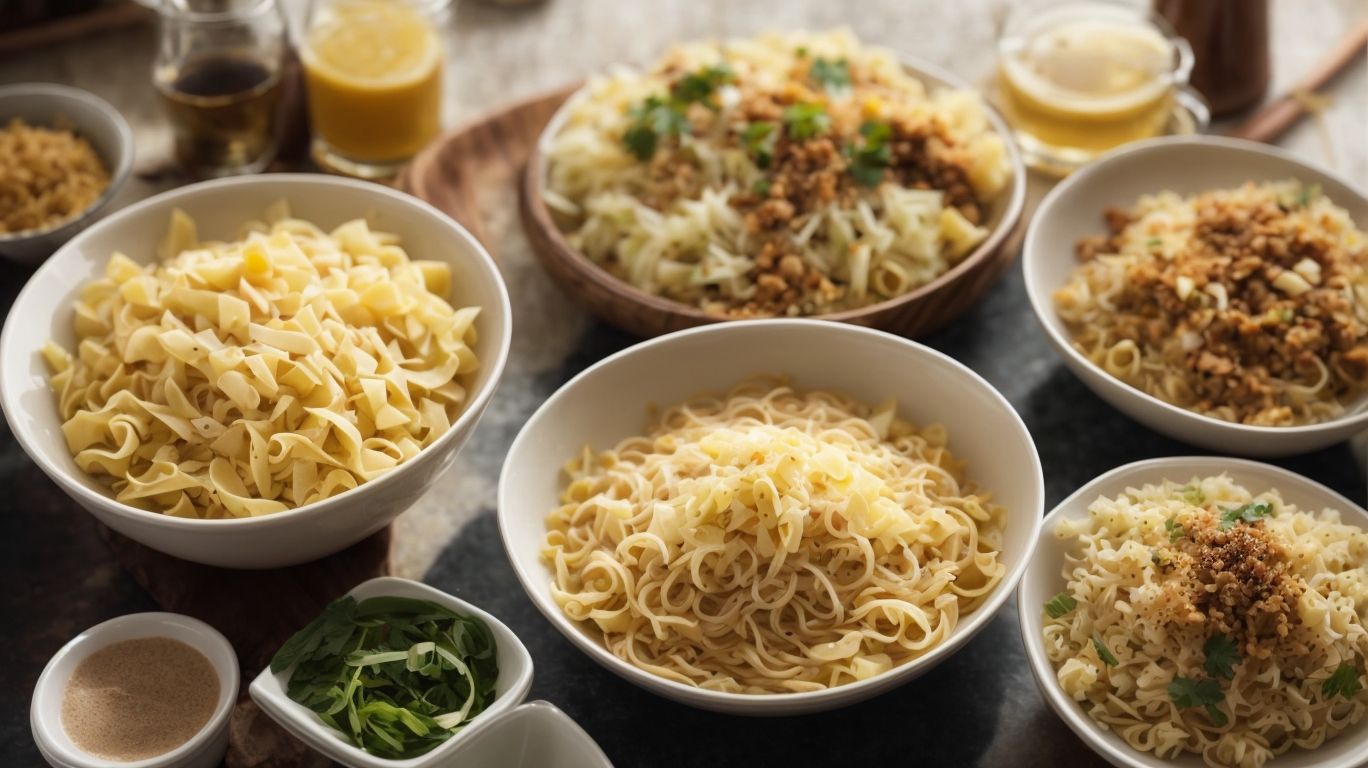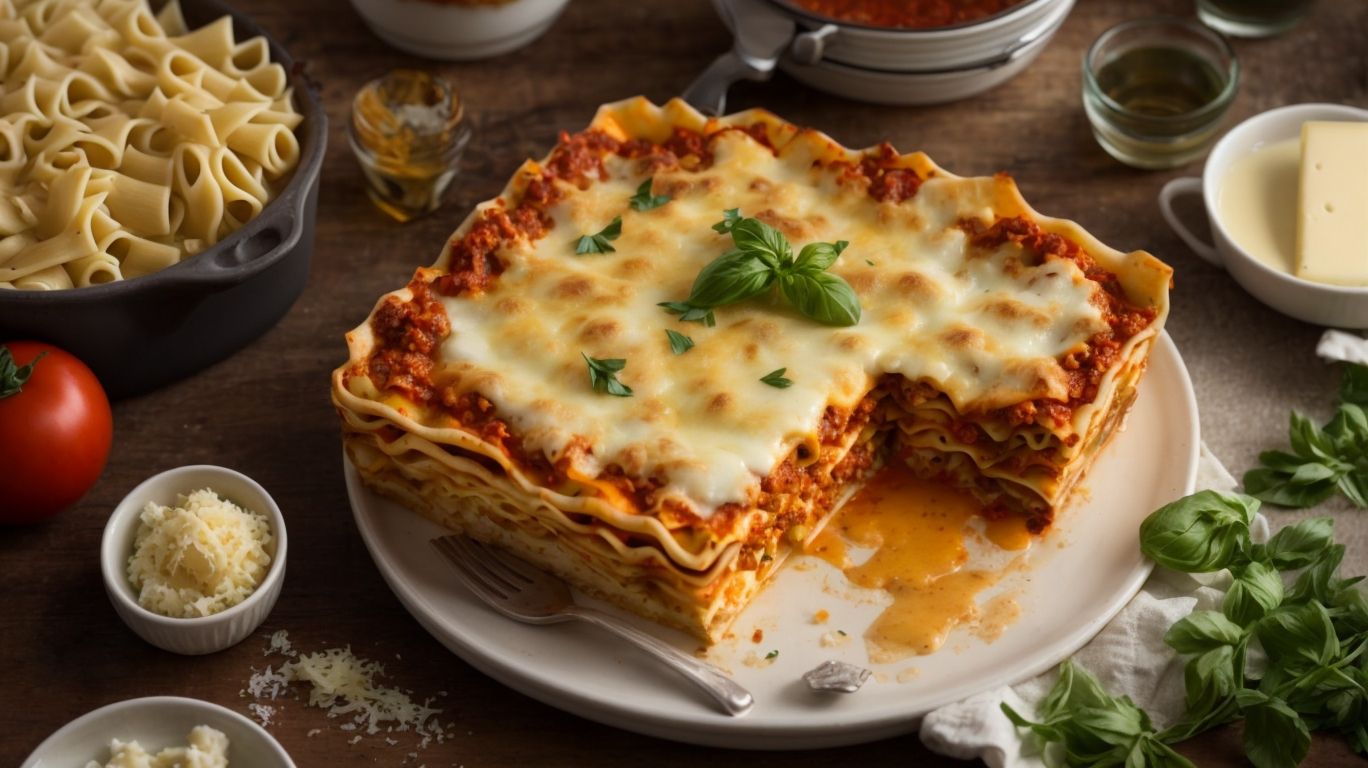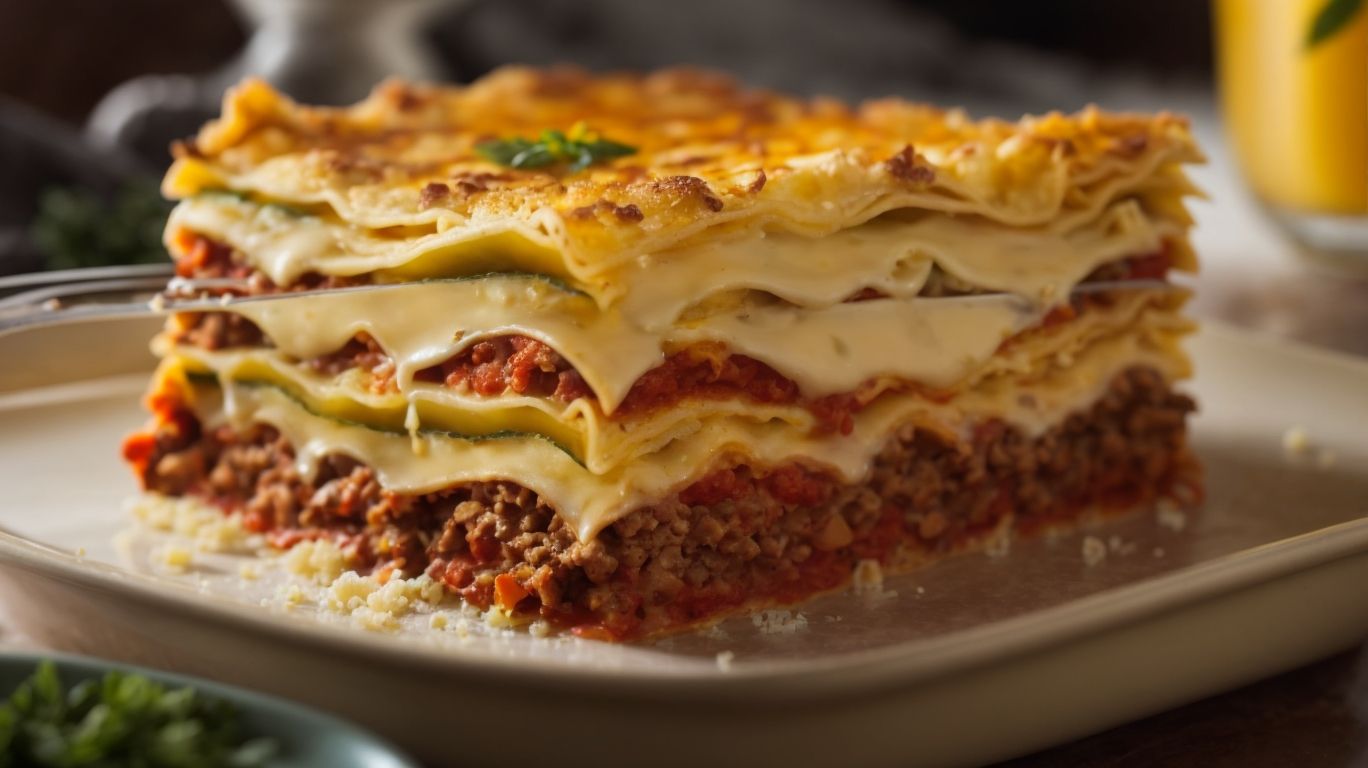How to Bake Lasagna Without Boiling Noodles?
Are you tired of the tedious process of boiling lasagna noodles before layering them in your dish?
We explore the benefits of baking lasagna without boiling noodles, including saving time and achieving a better texture and taste. We will also discuss the best types of noodles to use, preparation methods, layering tips, and the ideal baking time and temperature.
Discover how you can simplify the lasagna-making process without sacrificing flavor!
Key Takeaways:
Why Should You Bake Lasagna Without Boiling Noodles?
Baking lasagna without boiling noodles offers several advantages, including saving time and energy while enhancing the dish’s overall texture and flavor.
By omitting the traditional step of boiling noodles, you not only cut down on preparation time but also reduce the energy consumption involved in the cooking process. This streamlined approach is not only efficient but also results in a lasagna with a better texture, as the noodles cook directly in the sauce, absorbing all the delicious flavors as they bake.
The absence of pre-boiling also leads to flavor enhancements within the layers of your lasagna, as the noodles soak up the rich sauce, creating a harmonious blend of tastes with each bite. This method offers a hassle-free way to achieve a lasagna that is not only time-saving but also packed with intensified flavors and superior texture.
Saves Time and Energy
Opting to bake lasagna without boiling noodles is a time-saving and energy-efficient method that streamlines the cooking process.
This technique not only accelerates the overall cooking time but also reduces the energy consumption, making it a more sustainable option. By skipping the traditional step of boiling noodles separately, you eliminate the need for an extra pot on the stove, saving both time and effort.
This method allows you to experience the same delicious flavors and textures of a classic lasagna recipe in a fraction of the time. The layers of sauce, cheese, and noodles meld together effortlessly during the baking process, creating a delectable dish with minimal prep work.
Less Mess and Hassle
Baking lasagna without boiling noodles reduces the mess and hassle associated with traditional preparation methods, making it an easy and convenient option for home kitchens.
By skipping the step of boiling the noodles separately, this modern cooking hack simplifies the entire process into a seamless experience. You can effortlessly layer the uncooked noodles directly with your favorite cheese and sauce, saving time and effort in the preparation phase. The result? A scrumptious dish with rich, intertwined flavors—all achieved with this time-saving technique. The baking time remains consistent, ensuring that the lasagna cooks evenly without any unevenly cooked noodles disrupting the taste and texture.
Better Texture and Taste
By baking lasagna without boiling noodles, you can achieve a superior texture and enhanced flavor profile, elevating the overall culinary experience.
This cooking technique not only simplifies the preparation process but also allows the noodles to absorb the flavorful sauces and juices, resulting in a lasagna that is bursting with taste in every bite.
The layers of uncooked noodles in the lasagna dish soften during the baking process, creating a tender yet slightly firm texture that adds depth and richness to the overall dish.
Skipping the boiling step helps prevent the noodles from becoming mushy, ensuring that each layer maintains its structural integrity, complementing the luscious cheeses and savory fillings beautifully.
What Type of Noodles Work Best for Baking Lasagna?

Credits: Poormet.Com – Kenneth Harris
Selecting the right type of noodles is crucial when baking lasagna to ensure the perfect texture and flavor in your homemade dish.
When choosing the ideal noodles for your lasagna, consider the various options available to suit your preferences. Different types of noodles, such as traditional lasagna noodles, no-boil noodles, or even spinach or whole wheat variations, can bring distinct textures and flavors to your dish.
Experimenting with different ingredients in your lasagna, such as incorporating herbs or spices into the cheese mixture, can further enhance the overall taste profile. Whether opting for a classic lasagna recipe or exploring unique cheese combinations, the right noodle selection plays a significant role in elevating your culinary creation.
Oven-Ready Lasagna Noodles
Oven-ready lasagna noodles are a convenient option for baking lasagna, eliminating the need for pre-boiling and simplifying the preparation process.
Besides saving time on pre-cooking, these oven-ready noodles offer a consistent texture and ease of layering, making the construction of the lasagna dish a hassle-free experience.
Following the clear instructions provided on the packaging, you can swiftly assemble your lasagna by layering the noodles with sauce and other ingredients, then letting the oven work its magic.
These noodles are designed to cook perfectly as the dish bakes, absorbing flavors and moisture to deliver a delectable final product without any extra effort on your part.
Fresh Pasta Sheets
Fresh pasta sheets provide a delectable base for baked lasagna, offering a homemade touch and premium quality to your dish.
Using fresh pasta sheets elevates the flavors of the lasagna as they absorb the sauce better, resulting in a more harmonious blend of tastes. The texture of homemade pasta adds a tender yet chewy element, contrasting beautifully with the gooey cheese layers. When stacked with luscious ingredients, the pasta retains its shape without becoming mushy, ensuring a satisfying bite with each forkful. These fresh pasta sheets are versatile and can enhance a variety of dishes, making them a worthwhile investment for any home chef’s recipe repertoire.”
No-Boil Lasagna Noodles
No-boil lasagna noodles offer a time-saving and hassle-free option for baking lasagna, ensuring a quick and convenient preparation process.
By eliminating the traditional parboiling step, these noodles simplify the lasagna-making technique, making it more approachable for home cooks of all skill levels. With no need to boil the noodles separately, you can layer them directly into your dish with the sauce and cheese, streamlining the entire process.
How to Prepare the Noodles for Baking Lasagna?
Properly preparing the noodles is essential for baking lasagna to achieve the desired texture and flavor in your dish.
In terms of lasagna, the ingredients and sauce play crucial roles, but the noodles serve as the foundation that holds the whole dish together. To start, you should select high-quality lasagna noodles that are suitable for baking, ensuring they are cooked to perfection. The preparation process involves boiling the noodles until they are al dente, not fully cooked, as they will continue to soften in the oven. This step ensures that the noodles maintain their texture amidst the layers of cheese, meat, and sauce.
Soaking in Hot Water
Soaking lasagna noodles in hot water can help soften them before baking, enhancing the texture and ensuring optimal flavor absorption in your dish.
When soaking the noodles, ensure that the water is hot but not boiling, as boiling water can overcook the noodles and make them mushy. Let the noodles sit in the hot water for about 15-20 minutes until they become pliable and easy to layer.
This technique not only saves time during baking but also prevents the noodles from being undercooked in the final dish. Softened noodles also absorb the sauce better, creating a harmonious blend of flavors in every bite.
For a more elevated taste profile, you can even infuse the soaking water with herbs or a dash of olive oil to impart additional layers of flavor to the noodles. This simple step can make a significant difference in the overall taste and quality of your lasagna.
Using a Wet Kitchen Towel
Wrapping noodles in a wet kitchen towel can help keep them moist and pliable for baking, ensuring a tender texture and rich flavor in your lasagna.
This preparation technique is particularly effective when using lasagna noodles that tend to dry out quickly. By retaining moisture through the damp towel, the noodles are less likely to become brittle during cooking, resulting in a velvety smooth texture that complements the layers of sauce and cheese perfectly.
Adding Extra Sauce and Cheese
Layering extra sauce and cheese between the noodles can enhance the overall flavor and richness of your baked lasagna, creating a satisfying culinary experience.
When you add an extra layer of rich tomato sauce, it not only infuses each bite with a burst of tangy sweetness but also keeps the lasagna moist during baking. The cheese, whether it’s gooey mozzarella or sharp parmesan, forms a golden, melty crust that adds a delightful contrast to the soft noodles underneath.
This meticulous layering process ensures that every part of the dish, from top to bottom, is perfectly seasoned and packed with savory goodness. Your lasagna will not only look appetizing but will tantalize your taste buds with each forkful, making it a dish worth savoring.
What Are Some Tips for Layering Lasagna Without Boiled Noodles?

Credits: Poormet.Com – Joseph Ramirez
Mastering the art of layering lasagna is key to creating a delicious dish without boiled noodles, ensuring optimal texture and flavor in every bite.
Layering lasagna involves building a harmonious balance of ingredients that meld together during the baking process. A crucial aspect of this technique is the strategic arrangement of sauce, cheese, and pasta sheets, creating a symphony of flavors. The layering process allows the sauce to seep into the pasta, infusing it with rich taste, while the cheese forms a golden crust that adds a delightful crunch.
- This careful layering not only enhances the aesthetic appeal of the dish but also plays a significant role in its overall taste profile.
- By following the right technique, each layer contributes distinct flavors and textures, resulting in a lasagna that is both satisfying and memorable.
Start with a Thin Layer of Sauce
Begin the lasagna layering process with a thin, even layer of sauce to provide a solid foundation for building flavor and texture throughout the dish.
In terms of assembling a delicious lasagna, sauce plays a pivotal role in infusing every bite with a burst of flavor. By starting with the sauce as the base layer, you ensure that the essence of your chosen ingredients permeates the entire dish. This foundational step sets the stage for a harmonious blend of tastes and textures.
Layering sauces strategically between the cheesy goodness and tender noodles helps to keep the dish moist and cohesive. The sauce acts as a bridge that not only binds the different components together but also adds depth and richness to each bite.
Alternate Layers of Noodles and Sauce
Creating alternating layers of noodles and sauce is crucial for a well-balanced lasagna, ensuring even distribution of flavors and textures throughout the dish.
In terms of the art of layering, following the right instructions can make all the difference.
- Start with a layer of sauce at the bottom of the baking dish to prevent the noodles from sticking.
- Then, add a layer of noodles followed by a generous coating of sauce to keep them moist and flavorful.
- Repeat this process, making sure to end with a final layer of sauce.
Each layer contributes to the overall flavor profile and texture of the lasagna, with the cheeses melting into the sauces to create a delicious harmony.
End with a Layer of Cheese
Finishing the lasagna layering process with a generous layer of cheese adds a decadent touch and savory richness to the dish, enhancing both texture and flavor.
The cheese not only creates a luscious, gooey top layer that bakes to golden perfection but also infuses the entire dish with a wonderful creaminess. This final layer locks in moisture, preventing the noodles from drying out during baking, creating a harmonious blend of flavors and textures. As the cheese melts into the sauce, it forms a delectable fusion that elevates every bite. The cheesy topping also adds a satisfying crunch to contrast with the softness of the other layers, providing a delightful sensory experience.
What Is the Baking Time and Temperature for Lasagna Without Boiled Noodles?
Achieving the perfect bake for lasagna without boiled noodles requires precise control over time and temperature to ensure a well-cooked and flavorful dish.
In terms of baking lasagna, the key is to cook it slowly at a moderate temperature in the oven. This gradual cooking process allows the flavors of the sauce and cheese to meld together beautifully, resulting in a mouthwatering final dish. The preparation time for lasagna may take a bit longer, but the end result is definitely worth the wait.
It’s crucial to pay attention to the oven temperature as well. Too high a temperature can cause the top layer to burn while the insides remain undercooked. On the other hand, if the oven is too low, the lasagna might turn out soggy. Striking the right balance is essential for achieving that perfect bake.
Preheat the Oven to 375°F
Before baking lasagna without boiled noodles, preheat your oven to 375°F to ensure even cooking and optimal flavor development throughout the dish.
Proper preparation is key to achieving a delicious lasagna, and a crucial step in this process is preheating the oven.
- By reaching the specified temperature of 375°F, the layers of sauce, cheese, and noodles will cook evenly, creating a harmonious blend of flavors and textures.
Without preheating the oven, the lasagna may take longer to bake, resulting in uneven cooking and potentially undercooked sections.
Bake for 45-60 Minutes
Bake the lasagna without boiled noodles in a preheated oven for 45-60 minutes, allowing the flavors to meld and the dish to reach its full culinary potential.
To achieve that perfect result, start by preheating your oven to 375°F (190°C) for optimal cooking. While the oven is heating up, prepare your savory sauce with a combination of rich tomato puree, minced garlic, and a dash of oregano for that authentic Italian taste. Layer the uncooked lasagna noodles in a deep baking dish, followed by a generous amount of the meaty sauce and a lavish sprinkle of mozzarella and parmesan cheese.
Let It Rest Before Serving
Allow the baked lasagna to rest for a few minutes before serving to let the flavors settle and the dish achieve the ideal texture for a delightful dining experience.
Resting the lasagna post-baking is a crucial step in the preparation process. By allowing the dish to sit, the layers incorporating the rich sauce and tender noodles fuse together harmoniously. This resting period is essential for the lasagna to maintain its structure, enhancing the flavor profile and ensuring an enjoyable dining experience.
Frequently Asked Questions
1. How to Bake Lasagna Without Boiling Noodles?
To bake lasagna without boiling noodles, start by using oven-ready lasagna noodles. These noodles are designed to be used without boiling and will cook perfectly in the oven. Simply layer them into your lasagna dish as you would with regular boiled noodles.
2. Can I use regular lasagna noodles instead of oven-ready ones?
Yes, you can use regular lasagna noodles instead of oven-ready ones. However, you will need to boil them before using them in your lasagna dish. This adds an extra step and can be time-consuming, so using oven-ready noodles is recommended for convenience.
3. Do I need to adjust the baking time when using oven-ready noodles?
Yes, you may need to adjust the baking time when using oven-ready noodles. Since these noodles do not require boiling, they may cook faster than regular noodles. Check the package instructions for recommended baking times and adjust accordingly.
4. How do I prevent the lasagna from becoming soggy when using oven-ready noodles?
To prevent the lasagna from becoming soggy when using oven-ready noodles, make sure to layer them with plenty of sauce. The sauce will help to keep the noodles moist and prevent them from becoming dry or crunchy.
5. Can I make my own oven-ready lasagna noodles at home?
Yes, you can make your own oven-ready lasagna noodles at home by using no-boil lasagna sheets and cutting them to fit your dish. You can also use fresh lasagna sheets, but make sure to lightly coat them with oil before layering them into your dish.
6. Are oven-ready noodles healthier than regular boiled noodles?
Oven-ready noodles are not necessarily healthier than regular boiled noodles. They may have slightly different nutritional values, but both types of noodles are generally made from the same ingredients. It is more a matter of personal preference and convenience rather than health benefits.

